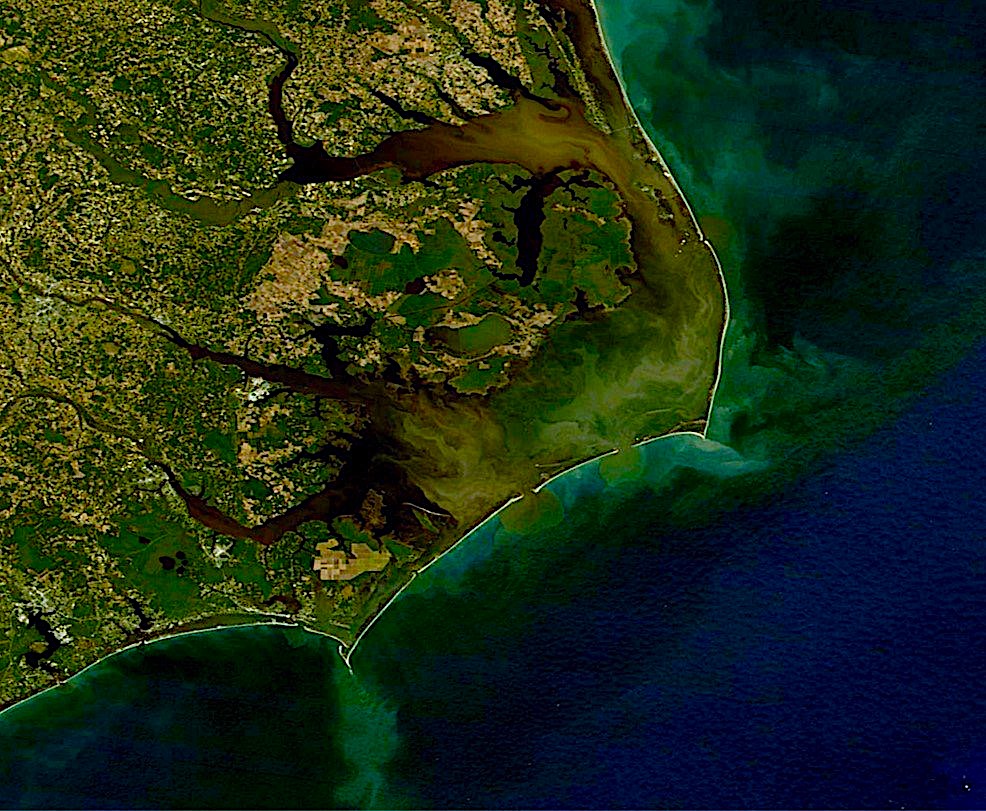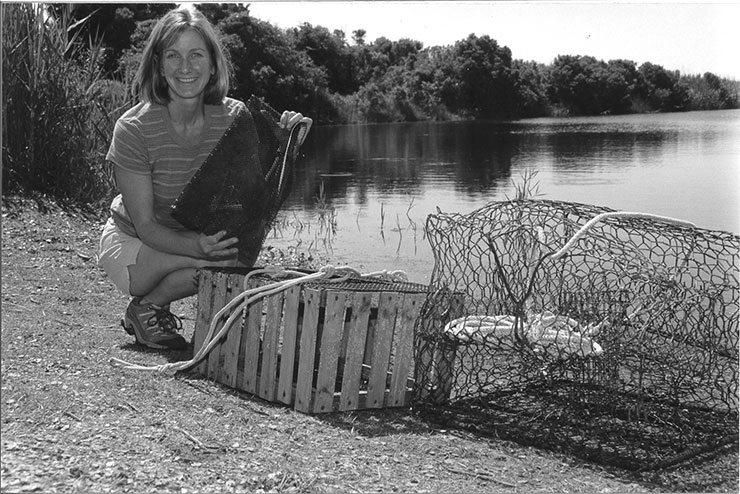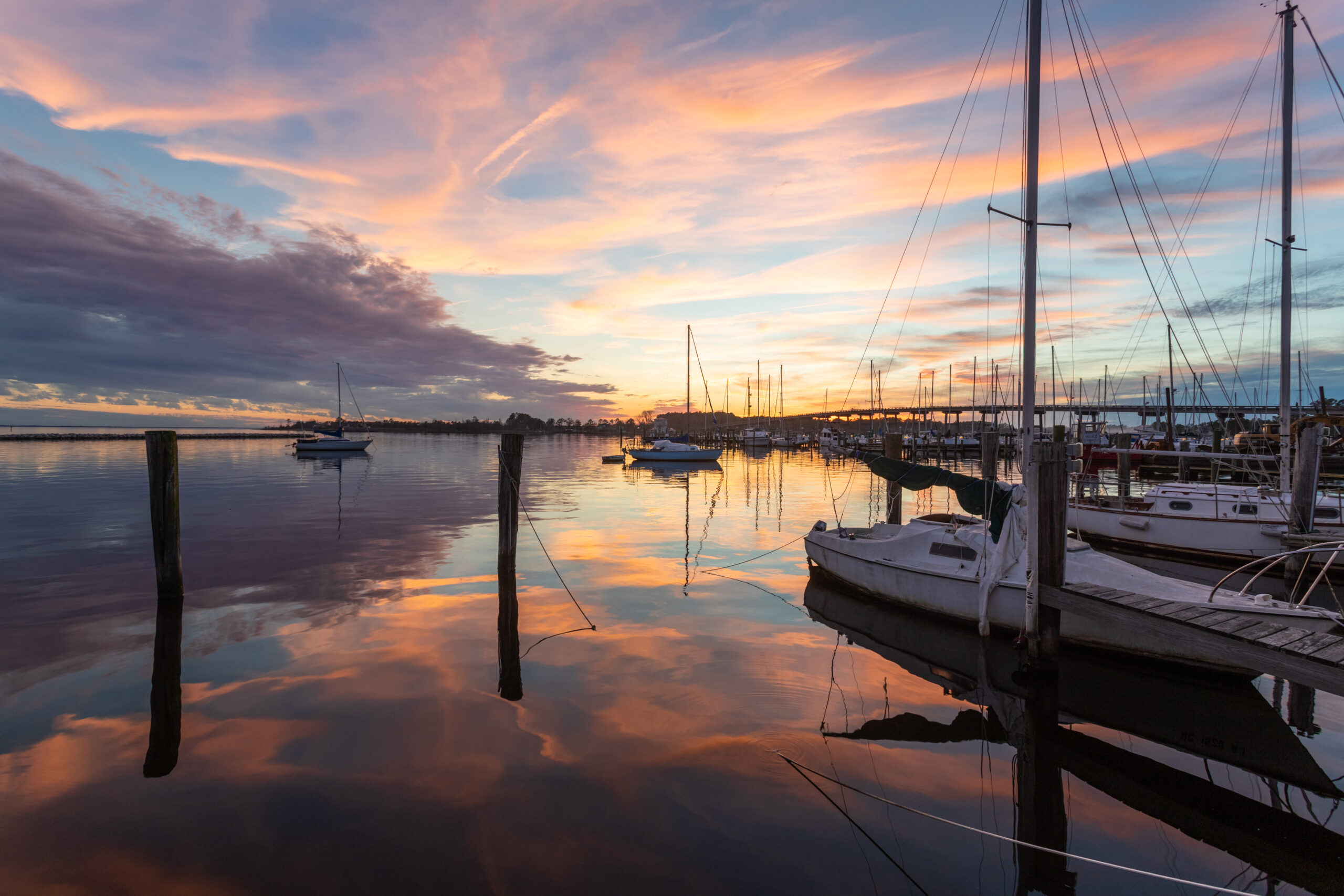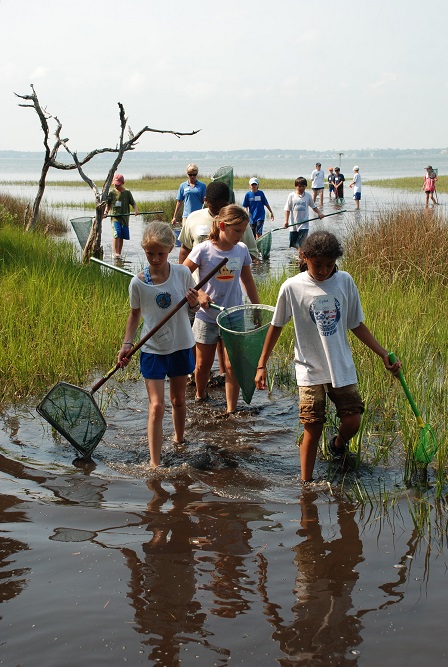Stan Riggs: Geologist Paints Vivid Picture of North Carolina’s Dynamic Shorelines

The brownish-green water from Roanoke Sound in Nags Head hits the heavily rip-rapped shoreline as North Carolina Sea Grant researcher Stan Riggs stands on a large concrete slab.
With the help of a large megaphone, Riggs’ voice booms across the estuarine shoreline while he points to a house perched on stilts in the sound.
“You see the house out in the sound,” says Riggs to N.C. Coastal Geology Research Cooperative field trip participants. “Even though there is rip rap on the shore, it is still eroding here as indicated by the difference between the 1997 and 2003 photographs.”
“From 1932 to ’73, the erosion rate was more than five feet a year,” adds Riggs, an East Carolina University distinguished research professor. “Since then, the shoreline has been armored with broken concrete slabs, but the rip rap is at best a temporary fix and not a permanent solution.”
Rugged and energetic, Riggs has recorded erosion rates along North Carolina’s 4,000 miles of estuarine shoreline for more than 30 years. To gather the data, he has trekked across soggy swamps, muddy marshes and hot, bare beaches.
“Stan is unique,” says David Mallinson, a former student of Riggs and ECU assistant geology professor. “He is so insightful and full of knowledge. He hasn’t slowed down mentally or physically in 20 years.”
Last year, after Hurricane Isabel, Riggs and his research team measured the erosion rate of the sediment bluffs along the Chowan River. During the storm, a surge of up to eight feet occurred within large portions of North Carolina’s estuarine system. Along the Chowan River, there were estimated 80 mph sustained winds and gusts up to 95 mph, according to Riggs.
“After Hurricane Isabel passed over the Chowan River, there was up to 80 feet of shoreline recession along portions of Chowan River bluffs,” he adds.
New Sea Grant Book
The bluff along the Chowan River is featured in the new North Carolina Sea Grant publication Drowning The North Carolina Coast: Sea-Level Rise and Estuarine Dynamics, written by Riggs and ECU Research Associate Dorothea V. Ames. The book builds upon Sea Grant’s Sound-front Series: Shoreline Erosion in North Carolina Estuaries by Riggs.
In the new book, the authors provide in-depth information about erosion processes and rates along North Carolina’s northeastern estuarine shoreline.
“We put the science of the estuarine system into a framework that could be understood by the public and coastal managers,” says Riggs. “Our estuarine system is an incredible resource that represents North Carolina’s natural capital. We must manage this coastal system as a nonrenewable natural and extremely dynamic resource if we hope to preserve it both for the short- and long-term future utilization and development of the state.”
Riggs began tracking shoreline erosion rates for the state’s coastal system in the 1970s with funding from North Carolina Sea Grant.
“This was a progressive idea for Sea Grant to fund such a study, prior to severe development pressure,” says Riggs. “At the time, not many people were interested in erosion rates along estuarine shorelines.”
Since then, Riggs and his colleagues have gathered data on short- and long-term erosion rates along the state’s estuarine shoreline. Recently, they consolidated the data for the book that can be used as ready reference for property owners, coastal managers, government officials, community planners, resource managers and educators.
“While much attention has been focused on the natural resources affecting the ocean shorelines, little has been directed to the forces acting on the estuarine shoreline, which is an equally vital resource,” says Charles Jones, director of the N.C. Division of Coastal Management.
“We are excited about the prospect of using Dr. Riggs’ research to further our understanding of these processes,” adds Jones. “I feel it is in the Division of Coastal Management’s interest to support studies and research in this area so that a better understanding can be applied in the development of coastal management and policies.”
Early Years
Riggs grew up in Green Bay, Wis., close to the Chequamegon-Nicolet National Forest. “As early as I can remember, I had a canoe paddle in my hand or rode my bike and explored the waters and shores of the Green Bay and Fox rivers,” he says.
“I never knew a time when I wasn’t interested in geology, biology and the natural history of what was around me,” adds Riggs. “When I was out on a lake or river, the whole business of water and its dynamics fascinated me.”
So Riggs pursued a major in geology while at Beloit College. As a freshman, he helped to organize a geologic field trip to the Appalachian Mountains in North Carolina.
“This was my introduction to North Carolina,” he says. “I clearly remember the Spruce Pine pegmatites and the Webster olivine ring dike, both world-class rock structures.”
The Appalachian Mountains were “warm, green and friendly compared to the raw, rugged and hostile Rocky Mountains,” recalls Riggs. “I thought then that North Carolina would be an awesome place to live.”
Riggs pursued a master’s in geology from Dartmouth College and then a doctorate in geology from the University of Montana.
After working in Alaska, New Mexico, Colorado and Florida, Riggs moved to Raleigh in 1964. Three years later, he relocated to ECU in Greenville, where he helped to start new geology and marine science programs.
During the late 1960s and early 1970s, Riggs lived on the Outer Banks and taught an interdisciplinary geology and biology program, — ECU by the Sea — for senior geology and biology majors.
As part of the course, Riggs and his students conducted “soggy-groggies,” or intensive field studies from Maine to Florida. To learn about coastal system dynamics, they spent days on the hot sand at Jockey’s Ridge — where they studied how the winds erode and deposit sand — and monitored the impacts of nor’easters and hurricanes on North Carolina beaches and inlets.
United Nations Project
From the late 1970s to early 1990s, Riggs conducted extensive studies on various types of mineral resources around the world.
As part of this effort, he served as co-director of a United Nations project involving resource utilization in developing countries. One of the program’s workshops was held at ECU, where Riggs brought together geologists from more than 40 countries.
“Stan helped geologists provide resources for people in developing countries,” says Scott Snyder, senior associate dean of ECU’s Thomas Harriot College of Arts and Sciences.
Because of his coastal work and worldwide resource project, Riggs received the O. Max Gardner Award in 1983. The Board of Governors of the University of North Carolina System gives the award annually to a faculty member who has made “the greatest contribution to the welfare of the human race.”
Riggs also has conducted extensive studies on the geologic framework and sediment dynamics associated with the North Carolina continental shelf and its rock hard bottoms. His work has provided critical information about potential sediment supplies for the barrier islands, as well as habitat data for marine ecosystems and associated fisheries.
Presently, Riggs is spearheading the ECU/U.S. Geological Survey (USGS)/N.C. Geological Survey (NCGS) Coastal Geology Cooperative Research Program that focuses on the geomorphic and ecologic dynamics and evolution of the northern Outer Banks and associated estuarine system.
This summer, Riggs and a team of researchers and graduate students are doing field work in the southern Pamlico and Core sounds, the Neuse and Pamlico rivers, the barrier islands from Ocracoke to Cape Lookout and the nearshore continental shelf.
Throughout his career, Riggs has spent a lot of time educating teachers and other public groups about the dynamics of North Carolina’s coastal system. Riggs’ workshops are a favorite with science educators.
Terri Kirby Hathaway, North Carolina Sea Grant marine education specialist, says that she has learned so much from Riggs over the years. When Riggs led a marine education field trip in the summer of 2000 to sites in eastern North Carolina hit by Hurricane Floyd, Hathaway says that the group was exhausted by the end of the afternoon.
“But Stan kept yelling: ‘Come on, let’s get going. We’re burning daylight,'” Hathaway recalls.
Marine educator Lundie Spence, who also has coordinated numerous field trips with Riggs, says that he brings the North Carolina islands to life by helping people visualize their dynamic and mobile nature.
“Stan makes people laugh with the joy of wind carrying sand,” adds Spence, director of the SouthEast Center for Ocean Sciences Education Excellence.
Field Trip
On a recent field trip for ECU/USGS/NCGS geologists, Riggs welcomes participants while standing on the estuarine shoreline at Jockey’s Ridge State Park in Nags Head.
“I hope you enjoy the stops and get a flavor of North Carolina’s barrier island system,” he says.
In the years before the Civil War, Riggs says Nags Head residents lived primarily within the maritime forest of Nags Head Woods.
Gradually, after the war, they began to move out of the woods to Old Nags Head along the estuarine shoreline and sell the ocean shoreline to vacationers, according to Riggs. “The 1932 map shows the recently paved coastal Hwy. 12 and the large Jockey’s Ridge and Seven Sisters dune fields,” he adds, holding up photos showing changes over seven decades. “Also notice the few oceanfront houses along a very wide ocean beach.”
In the late 1930s, the government built barrier-dune ridges to prevent overwash and encourage other development, says Riggs, gazing at the group with his gray-blue eyes.
“By 1999, you can see coastal N.C. 12 is very close to the ocean, and all of the old houses have been moved back significantly and are now up against the highway,” he adds. “The Seven Sisters Dune Field also has been totally developed by 1999.”
Once Jockey’s Ridge became a state park, the human forces from large numbers of visitors — in concert with extensive development and vegetation growth around the park — began to tear down the dune, says Riggs. “Over the years, Jockey’s Ridge has shrunk in size from 156 feet in the 1950s to less than 90 feet high today,” he adds.
Erosion at South Nags Head
After leaving Jockey’s Ridge, Riggs, dressed in jeans, a green jacket covered with a work vest, tennis shoes and baseball hat, leads the group for more than 12 hours to various sound and beach sites. He takes a break from lecturing only when traveling between stops.
At South Nags Head, Riggs walks at a brisk pace down the beach past homes that have been condemned because major beach erosion has exposed or eliminated septic systems.
“Years ago, when this area was first developed, houses were built way back from the ocean,” he says. “But the very high rates of shoreline erosion along this segment quickly encroached upon them and began taking out the oceanfront houses.
“At South Nags Head, the erosion rate is up to 20 feet a year,” says Riggs. “This caused the second and third row homes to systematically become oceanfront homes.”
Throughout the rest of the field trip, Riggs, who often sounds like an evangelist giving a sermon, keeps the group’s attention by using colorful anecdotes about the barrier island.
Toward the end of the trip, Riggs’ enthusiasm doesn’t wane as he climbs more than 200 steps in the Cape Hatteras Lighthouse.
Standing at the top of the lighthouse that overlooks the beach and woods, he describes the ocean and estuarine dynamics maintaining the barrier islands. He points out the classic beach ridge sequences that make up the landmass of Buxton Woods.
“This area has the highest ocean wave energy along the entire East Coast,” says Riggs. “In addition, there is a very large estuarine sea, known as Pamlico Sound, that works along the back side of the barrier island.”
Riggs’ last stop is at Hatteras Village, where Hurricane Isabel cut an inlet 1,700 feet wide and up to 28 feet deep, in a weak segment of the barrier island in September 2003. The U.S. Army Corps of Engineers then filled the inlet with sand dredged from the Hatteras Inlet channel and rebuilt the barrier-dune ridge. The state rebuilt N.C. 12.
As the sun is setting at the former site of Isabel’s inlet, Riggs leads a group along the beach. He points out the large peat blocks that are the size of a wheel barrel.
“This peat formed in the marsh about 200 years ago when the Hatteras Island shoreline was about five football fields seaward of the present location,” he says. “The rapid recession of this shoreline has moved the beach over the former marsh, causing the peat to crop out in the low-tide surf zone, where it has eroded during storms.”
Further down the beach, Riggs holds up an aerial photo of Isabel’s inlet shortly after it opened and took out a portion of N.C. 12. “If you walk back into the marsh,” he says, “you will see large pieces of pavement from the old road.”
Riggs says that about 25 miles of N.C. 12 has “hot spots” that were either damaged or destroyed by Hurricane Isabel and will continue to be threatened by future storms.
“In response to storms such as Hurricane Isabel, the state of North Carolina must put the science on the table before major decisions are made concerning the long-term maintenance of Hwy. 12, as well as future management decisions concerning new inlets,” he says. “Sea level will continue to rise. Storms will continue to directly impact our barrier islands.”
“The question is: can and will we learn to live with the dynamic nature of barrier islands — or will we destroy the barriers while attempting to stabilize the islands to protect our economic investments?” says Riggs.
The research presented in Drowning the North Carolina Coast was funded by North Carolina Sea Grant, U.S. Geological Survey, East Carolina University, National Park Service, U.S. Fish &Wildlife Service and Environmental Defense. The book was published with grants from the National Oceanic & Atmospheric Administration, the N.C. Division of Coastal Management and the Albemarle-Pamlico National Estuary Program.
Single copies of the book are $25. To order a copy of the book, refer to publication UNC-SG-03-04 and send a check to: North Carolina Sea Grant, NC State University, Box 8605, Raleigh, NC 27695-8605. Order forms are available from www.ncseagrant.org.
This article was published in the High Season 2004 issue of Coastwatch.
For contact information and reprint requests, visit ncseagrant.ncsu.edu/coastwatch/contact/.
- Categories:


